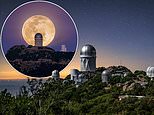
An Arizona observatory is providing unrivaled views of the night sky as part of a thousand-dollar package that offers guests the full astronomer experience.
The National Science Foundation’s NOIRLab, a federally-funded research center, has been welcoming overnight visitors for almost three decades.
The Overnight Telescope Observing Program, or OTOP – which starts at $945 for a single room and reaches up to $1,350 for a double – appoints four guests ‘visiting astronomers’ at one of three designated telescopes.
‘We are a working observatory. Every night our domes are open, doing science, while our Visitor Center program is another part of our mission to educate and inform the public,’ said Michelle Edwards, Associate Director at Kitt Peak National Observatory.
Upon making the trek to the mountaintop campus, 56 miles outside Tucson, visitors will become acquainted with the premises before hunkering down until dark, when the real fun begins.
Kitt Peak National Observatory sits just over 50 miles outside of Tucson, Arizona, and is home to several telescopes
The observatory, operated by the National Science Foundation’s NOIRLab, invites overnight guests to examine the starry sky. Pictured: the Visitor Center Roll Off Roof Observatory
The 20-hour experience, which comes with a thousand-dollar price tag, includes dinner, a dorm room and the assistance of a professional scientist
A visit runs from 3pm to 11am the following day. Upon arrival at the Visitor Center, guests are introduced to their telescope operator, who will lead them to their dorms in a rustic building styled like a 1950s motel.
‘These accommodations are ones the astronomers have been using for decades. You’re basically staying where the astronomers stay,’ Edwards explained.
After settling in, guests normally reunite with their guide to watch the sunset. As soon as a telescope becomes available, visitors are unleashed upon the night sky.
The telescope operator will help them use the powerful scientific instruments and locate certain deep-sky objects. Guides, who are astronomy enthusiasts themselves, may compile an observing list, or leave it up to the guests.
‘Obviously, planets are very popular, so if Jupiter or Saturn are available, we’ll be looking at them,’ said Angel Singleton, Kitt Peak Visitor Center supervisor.
Around this time of year, she says, the Orion Nebula is one of the most spectacular objects in the winter sky, containing hundreds of glittering infant stars.
Other highlights include Messier 13, a globular star cluster that forms a frozen firework when viewed through a telescope.
Prospective visitors are encouraged to inquire in advance if certain objects will be visible on their trip, as parts of the sky will not be above the horizon on a given night and some objects may be too faint.
However, no prior experience is necessary to participate, as ‘you don’t have to be an expert in astronomy,’ according to Edwards.
No prior experience is needed to use one of four designed telescopes on the campus. Pictured: the Visitor Center 0.5-meter Telescope
The NOIRLAB asks guests to email in advance if they want to see certain celestial bodies, as ‘parts of the sky will not be above the horizon on a given night and some objects are too faint to see’
Kitt Peak has been welcoming guests since around 1998, and the overnight program has proven to be one of its most popular offerings. Pictured: the Visitor Center after its remodeling in 1978
Kitt Peak reopened its doors after shutdowns due to the pandemic and a destructive wildfire. Pictured: the Visitor Center Levine 0.4-meter Telescope
Kitt Peak was formerly closed due to the pandemic and the 2022 Contreras Fire, which charred trees and seared the road leading to the observatory.
‘The Arizona Department of Transportation launched a multi-million-dollar project to actually repair that road, and that did take a considerable amount of time,’ Edwards said.
Flames knocked out grid power and caused damage to the interior that took months to assess.
The fire also caused the loss of one dorm, one cabin on the southwest ridge and a shed behind the fire barn.
‘The Visitor Center was closed for almost three and a half years. OTOP restarted in spring 2023,’ Edwards explained. ‘The rest of our programs, day tours and shorter nighttime programs, were all delayed until September of this year.’
OTOP, which launched around 1998, has proven to be especially popular, with all dates currently sold out through the end of the year.
The facilities are located a whopping 2096 meters up the mountain, which sits on land belonging to the Tohono O’odham Nation.
Tribal members are able to utilize most programs at the observatory for free, and Kitt Peak often hosts student groups.
The road leading to the observatory was closed after the 2022 Contreras Fire. Pictured: a rockslide that occurred in the aftermath of the wildfire
The facilities are located a whopping 2096 meters up the mountain and offer breathtaking views of the Milky Way. Pictured: the Visitor Center 0.5-meter Telescope
Guests will be joined by a telescope operator, who will help them use the instruments and can compile an observing list upon request. Pictured: the 0.4-meter Telescope inside the Roll Off Roof Observatory
The NOIRLab facilities reopened to the public in June 2023, including locations in Hawaii and Chile
During an overnight visit, guests may use the Levine 0.4-meter telescope and the 0.5-meter telescope, both enclosed by domes.
The 0.5-meter telescope, located next to the Visitor Center, is the largest one available – and the most convenient, due to location.
There is also a roll-off roof observatory, or ROR, that offers striking views of the Milky Way.
‘That one is a great way to give the guests a view of the night sky that’s different from just a regular telescope dome,’ Singleton said.
‘While they’re waiting for their turn to look through the telescope, they just have the entire night sky above them to be able to look and watch for meteors or satellites going by.’
The cafeteria stays open all hours, so hungry guests may duck inside to refuel with a sandwich or hot chocolate before resuming their hunt for celestial bodies.
Due to the duration of the program, it is recommended for guests 12 and up.
‘We’ve had teenagers and older children accompanying their parents,’ Edwards said. ‘The guides are there to be good hosts, so they will work with you and the amount of experience you have.’
The now-defunct McMath-Pierce Solar Telescope was once the largest solar telescope in the world
Telescopes on the property may encounter malfunctions, which representatives say are due to the rapid reopening in the wake of the pandemic. In that case, a refund will be offered
Overnight visits are priced at a starting rate of $945 on Eventbrite and include a tour of the campus
A weather check is performed at 10am, before guests arrive, to ensure that conditions will be hospitable. Refunds are offered in full, minus the Eventbrite fee, if the facility is forced to cancel due to weather or safety concerns.
Other telescopes guests may see on their campus tour are among the most impressive in the world.
One, the Nicholas U. Mayall 4-meter telescope, is renowned for its discovery of methane ice on Pluto and boasts the largest scope on the mountain.
‘It has a single dedicated purpose,’ Edwards said. ‘There is funding that’s come from the Department of Energy to build a special instrument called DESI (Dark Energy Spectroscopic Instrument).’
This instrument is on a five-year mission to create the best three-dimensional map of the universe by understanding where galaxies are in relation to Earth.
The enormous WIYN 3.5-meter telescope, whose NEID instrument is designed to measure the motion of stars with extreme precision, is a state-of-the-art exoplanet hunter. Its mission, Edwards explains, is to scope out Earth 2.0.
While decommissioned, the McMath–Pierce solar telescope was for many decades the largest solar telescope on the globe.
Through a $4.5 million grant, it will be fully renovated and turned into an educational building called Windows Center on the Universe.
‘Our primary goal is actually a scientific goal,’ Edwards explained. ‘Probably more than 500 astronomers are served by the observatory and dozens of institutions.’
She added: ‘You’ll be able to hear the domes rotating as you’re walking around. So you’ll be able to really hear and see science being done right in front of you. And really exciting science.’
Source link
CHECK OUT: Top Travel Destinations
READ MORE: Travel News



